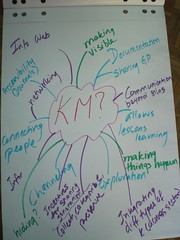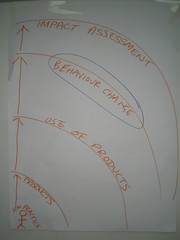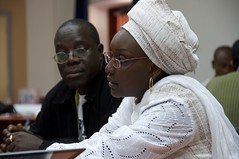
“All good things come to an end,” so says Roxanna Samii (International Fund for Agricultural Development – IFAD) in her heartfelt blog post about her last day at the Fair. “The purpose of this Share Fair was to share and learn and I believe that we’ve achieved this goal. I hope that the Fair has left a footprint in the hearts, minds and souls of the participants.”
Roxanna also talks about the radio and telecentre focus groups she attended during the last day. “The radio session was a great example of the impact of the Share Fair,” she says. “The room was packed with participants who before the Share Fair did not know anything about podcasting, podcasting/audio software and hardware. Three days later, here they were showing us the audio files they have created, sharing tips on how to conduct an effective interview and discussing challenges of interviewing with the help of an interpreter and avoiding being lost in translation.
“We closed the radio session with one of the participants saying: ‘YES WE CAN. I now know HOW TO.’ That was such a wonderful way of finishing the session and showed the footprint of the share fair. Often we are asked ‘what has been the impact of events such as share fair?’ The impact of these events is transformative. They change the way people work. They open your mind and remove the cobwebs in your mind, and as a result you inevitably change behaviour, which is transformative.”
Read more about Roxanna’s parting thoughts here.
Making Knowledge Travel
Day Three also saw the ICT-KM Program’s Nadia Manning-Thomas facilitating a “sold-out” session on how to make knowledge travel. She talked about the difficulties associated with getting the right information to the right people at the right time, and the role we can all play in making knowledge travel. She also discussed two initiatives involving the ICT-KM Program that facilitate knowledge sharing: the Triple A Framework, which looks at the availability, accessibility and applicability of research outputs, and the CIARD initiative, which aims to make research results more accessible and usable by stakeholders.
Coming soon: look out for Nadia’s post on this session!
The law of two feet
In his blog post on open space, Andrew Clappison (CommConsult) talks about applying the open space approach to meetings and workshops. One of the main advantages of this face-to-face methodology is that participants can take responsibility for a meeting’s agenda by deciding the topics they want to discuss. However, if an open space sessions goes in a direction that is not to your liking, you are free to apply “The law of two feet” and move onto another session. Of course, if you invoke this law in a meeting that follows a more traditional agenda approach, there might be consequences. Read Andrew’s full post here.
Knowledge Management Impact Assessment session
Day Two Update: This lively session gave knowledge management (KM) practitioners an opportunity to share their experiences and discuss the challenges associated with measuring/assessing the impact of KM initiatives. Open space techniques (Open Popcorn and World Cafe) were used to facilitate the sharing and exchange of experiences and knowledge. The discussion will also provide input to the Knowledge Management Impact Challenge initiative. Despite the great challenge of the KM impact question, the participants dived into lively group debates around 3 questions (accountability, learning and ownership) to think about why it is important for us to be able to explain the changes that result from KM activities, share their experiences of different tools and approaches and work together to think about what we can do better to address this issues. Read the session summary by co-facilitator Louise Clark (Impact Alliance).
During the Share Fair, blog posts, like the ones mentioned above, were generated by our social media team. This group of enthusiastic volunteers headed by Peter Casier comprised participants and facilitators alike, people who took time out of busy schedules to report on the various sessions that took place. I would like to say a big thank you to everyone who helped cover sessions so that others unable to attend could get some insights into how we can all work better together. And if you wonder what social media really is… you may want to read Peter’s post. I am sure you will read more about the lessons learned in organizing such a “controlled anarchy” group.
The Share Fair is now over but you can read the Social Media Team’s coverage on the Share Fair official blog as well as the individual sites of the various tools used:
• Blog: http://tinyurl.com/sfaddisblog
• Wiki: http://tinyurl.com/sfaddiswiki
• Tweets: http://tinyurl.com/sfaddistweets
• Photos: http://tinyurl.com/sfaddisphotos
• Videos: http://tinyurl.com/sfaddisblips
• Social web: http://tinyurl.com/sfaddismention
• Share fair FM: http://tinyurl.com/sfaddisfm
As to myself…. weeks and weeks of preparations and four days of intense interactions have come to an end.. a great team worked to make this possible (special mention to Peter Ballantyne and the ILRI crew who did an amazing job!) we were responsible for organizing the Day 0 (where we delivered more than 350 training ’seats’) and the social media coverage…. and yes… I look back with a great sense of pride… I will write more about that once I come down from “cloud 9″ and catch up with my emails


 Owen Barder - a charismatic and compelling speaker - delivered an
Owen Barder - a charismatic and compelling speaker - delivered an 

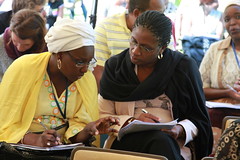
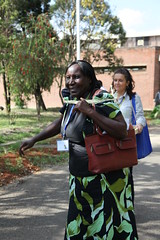

 Un coup de cœur tout particulier pour Gladson, journaliste au Malawi. Il a commencé par constaté, ou plutôt rappelé, que la plupart du temps les petits paysans sont les bénéficiaires qui reçoivent des services produits par d’autres, tels les résultats de recherche par exemple. Pour son programme de radio, il change les rôles : il fait des petits paysans des chercheurs qui présentent les résultats de ce qu’ils font sur leurs champs, lorsqu’ils essaient une nouvelle pratique ou constatent des changements. Le programme de radio a eu pour effet que le ministère de l’Agriculture du Malawi a du renforcer la formation des vulgarisateurs agricoles, de manière à ce qu’ils puissent bien répondre aux questions que les paysans (qui ont écouté le programme) viennent leur posé après l’émission.
Un coup de cœur tout particulier pour Gladson, journaliste au Malawi. Il a commencé par constaté, ou plutôt rappelé, que la plupart du temps les petits paysans sont les bénéficiaires qui reçoivent des services produits par d’autres, tels les résultats de recherche par exemple. Pour son programme de radio, il change les rôles : il fait des petits paysans des chercheurs qui présentent les résultats de ce qu’ils font sur leurs champs, lorsqu’ils essaient une nouvelle pratique ou constatent des changements. Le programme de radio a eu pour effet que le ministère de l’Agriculture du Malawi a du renforcer la formation des vulgarisateurs agricoles, de manière à ce qu’ils puissent bien répondre aux questions que les paysans (qui ont écouté le programme) viennent leur posé après l’émission. 